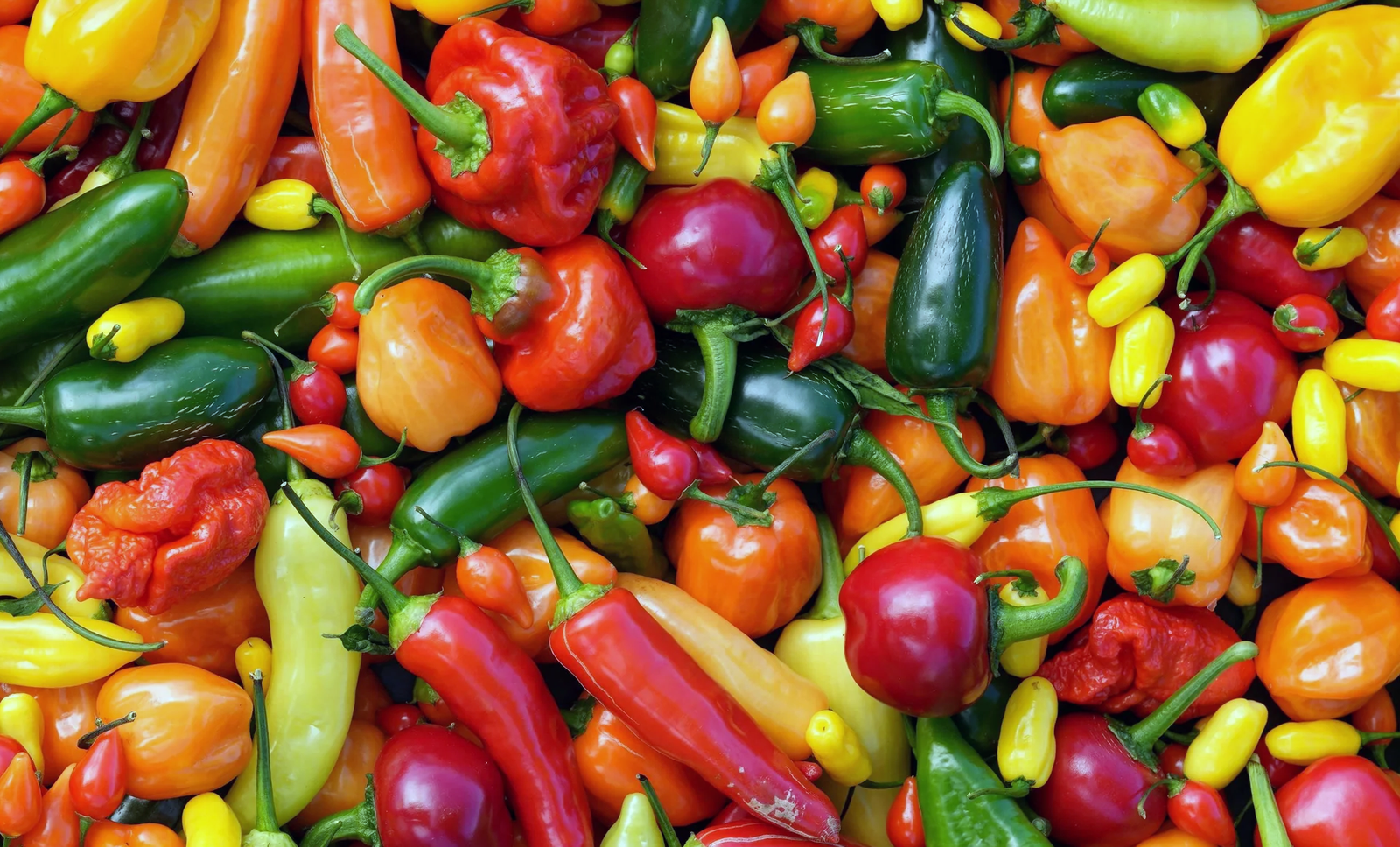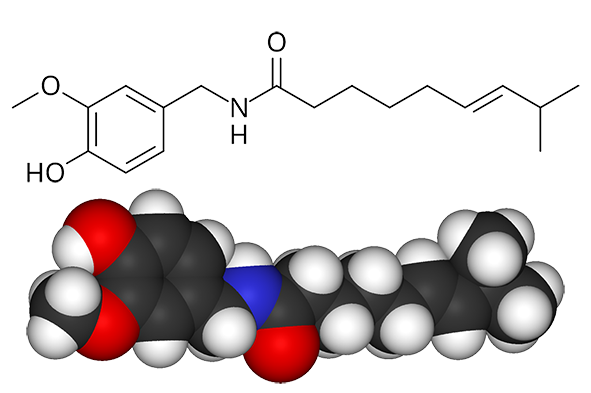FabulousFusionFood's Chilli-based Recipes 7th Page
 A mixture of different chilli peppers.
A mixture of different chilli peppers.
Welcome to FabulousFusionFood's Chilli-based Recipes Page — The recipes presented here all contain chilli peppers as a main ingredient. Chillies are the fruit of the chilli plant. Along with black pepper, they are unique spices in that they impart 'heat' to a dish without any associated bitterness. The dried and powdered fruit along with the fresh fruit and the dried fruit are all used as spices. As well as their capsaicin induced heat, chillies (depending on the variety or cultivar) can also imbue a dish with a fruity flavour. Smoked chillies are also used to impart a smokiness as well as heat to a dish.
Chilli peppers, also spelled chile or chili (from Classical Nahuatl chīlli [ˈt͡ʃiːlːi]) and known as hot peppers, are varieties of berry-fruit plants from the genus Capsicum, which are members of the nightshade family Solanaceae, cultivated for their pungency. Chilli peppers are widely used in many cuisines as a spice to add "heat" to dishes. Capsaicin and the related capsaicinoids give chillies their intensity when ingested or applied topically. Chilli peppers exhibit a range of heat and flavours. This diversity is the reason behind the availability of different types of chilli powder, each offering its own taste and heat level.
Chilli peppers originated in Central or South America and were first cultivated in Mexico. European explorers brought chillies back to the Old World in the late 16th century as part of the Columbian Exchange, which led to the cultivation of multiple varieties across the world for food and traditional medicine. Five Capsicum species have been widely cultivated: annuum, baccatum, chinense, frutescens, and pubescens.
 The capsaicin molecule, chemical structure (top) and space-filling model (bottom).
The capsaicin molecule, chemical structure (top) and space-filling model (bottom).
When peppers are consumed by mammals such as humans, capsaicin binds with pain receptors in the mouth and throat, potentially evoking pain via spinal relays to the brainstem and thalamus where heat and discomfort are perceived. However, birds are unable to perceive the hotness and so they can eat some of the hottest peppers. The intensity of the "heat" of chillies is commonly reported in Scoville heat units (SHU), invented by American pharmacist Wilbur Scoville in 1912. Historically, it was a measure of the dilution of an amount of chilli extract added to sugar syrup before its heat becomes undetectable to a panel of tasters; the more it has to be diluted to be undetectable, the more powerful the variety, and therefore the higher the rating. Since the 1980s, spice heat has been assessed quantitatively by high-performance liquid chromatography (HPLC), which measures the concentration of heat-producing capsaicinoids, typically with capsaicin content as the main measure
The alphabetical list of all the chilli-based on this site follows, (limited to 100 recipes per page). There are 1306 recipes in total:
Page 7 of 14
| Khatta Meetha (Cabbage Curry) Origin: India | Laksa Paste Origin: Singapore | Maïs Grillé (Barbecued Corn Cobs) Origin: Niger |
| Khichiri Prawn Sauce Origin: India | Laksa Paste Origin: Malaysia | Maacher Chop (Indian Fish Croquettes) Origin: India |
| Khnom Jin Namya (Catfish Curry over Noodles) Origin: Thailand | Laksa Paste II Origin: Malaysia | Maacouda bil Batata (Potato Omelette) Origin: Tunisia |
| Khowsuey Origin: Chile | Lamb Dhan Saag Origin: India | Maafé Origin: Mali |
| Kibeba (Cassava and Cuttlefish Stew) Origin: Mozambique | Lamb Jalfrezi Origin: India | Maboke (Steamed Nile Perch) Origin: Central African Republic |
| Kibeba de Angola Origin: Angola | Lamb Koftas Origin: North Africa | Macaroni Salad Origin: American |
| Kima (Chopped Beef and Chilli Fry) Origin: Senegal | Lamb Rogan Josh Origin: India | Madaba (Cassava Leaf and Coconut Stew) Origin: British |
| Kiseli Kupus Origin: Croatia | Lao Tam Som (Lao Green Papaya Salad) Origin: Laos | Mafé Origin: Senegal |
| Kissuto Rombo (Baked Kid Goat) Origin: Sao Tome | Lasary Citron (Lemon Condiment) Origin: Reunion | Mafé Malienne (Malian Mafé) Origin: Mali |
| Kobi Bhaji Origin: India | Lasary Manga (Mango Condiment) Origin: Madagascar | Maffi Gumbo (Okra Sauce) Origin: Guinea |
| Kobi Keema (Cabbage and Minced Meat Curry) Origin: India | Lauki Raita (Bottle Gourd Raita) Origin: India | Maffi Hakko Origin: Guinea |
| Kobi Sabji (Cabbage Sabji) Origin: India | Le Koki (Bean Cake) Origin: Chad | Maffi Hakko Bangtura (Sweet Potato Leaf Sauce) Origin: Guinea |
| Kofta Curry (Meatball Curry) Origin: Pakistan | Le Koki de Cameroun (Cameroonian Bean Cake) Origin: Cameroon | Maharagwe (Spiced Red Beans in Coconut Milk) Origin: Kenya |
| Koki Origin: Cameroon | Le Ndolé Camerounais (Cameroonian Ndolé) Origin: Cameroon | Maharashtrian Masala Bhat (Spicy Maharashtrian Rice) Origin: India |
| Kokoda (Fijian Ceviche) Origin: Fiji | Le Rougail Boucané (Smoked Pork Rougail) Origin: Reunion | Mahjouba (Algerian Crêpes) Origin: Algeria |
| Kokum Kari (Kokam Curry) Origin: India | Leftover Roast Beef Jalfrezi Origin: Anglo-Indian | Makher Taukari (Fish Curry) Origin: Bangladesh |
| Komprek Eromba (Water Dropwort Eromba) Origin: India | Leftovers Jalfrezi with Gravy Origin: India | Makher Taukari II (Fish Curry II) Origin: Bangladesh |
| Kondré de Porc (Kondré of Pork) Origin: Cameroon | Leksour (Lamb Stew on Millet Pancakes) Origin: Mauritania | Makhni Curry Sauce Origin: India |
| Konkoé Turé Gbéli (Smoked Catfish Stew with Vegetables) Origin: Guinea | Lemongrass Curry Origin: Cambodia | Malawi Curry Powder Origin: Malawi |
| Kontomire Stew (Cocoyam Leaf Stew) Origin: Ghana | Lemongrass Pork with Rice Noodles Origin: Australia | Malay Chicken Kurma Origin: Malaysia |
| Korma Masala Origin: India | Lentil Curry with Rhubarb and Sweet Potatoes Origin: Fusion | Malaysian Chicken Satay Origin: Malaysia |
| Koshari (Egyptian lentils) Origin: Egypt | Lentil Or Potato Tempering Origin: India | Malaysian Fish Curry Powder Origin: Malaysia |
| Kouti (Cassava Croquettes) Origin: Guinea | Lesothan Chakalaka Origin: Lesotho | Malaysian Goat Rendang Origin: Malaysia |
| Kpakpo Shito (Fresh Shitor) Origin: Ghana | Liberian Jollof Rice Origin: Liberia | Malaysian Laksa Origin: Malaysia |
| Krain Krain (Jute Leaf Stew) Origin: Sierra Leone | Lightly-brined Turkey Origin: Britain | Malaysian Lamb Rendang Origin: Malaysia |
| Kuchela Origin: Trinidad | Lobsgows Gorllewin Affrica (West African Lobscouse) Origin: Welsh | Maldives Meat Curry Powder Origin: Maldives |
| Kuka Soup Origin: Nigeria | Logosta Assada (Roasted Lobster) Origin: Guinea-Bissau | Malian Simbala Powder Origin: Mali |
| Kurmanash Origin: India | Lonumiru Curry Powder Origin: Maldives | Mallow Leaf Gumbo Origin: Britain |
| La Capitaine Sangha (Nile Perch with Red Sauce) Origin: Mali | Lonumirus (Maldives Chilli Sambal) Origin: Maldives | Mallow Leaf Peanut Sauce Origin: Fusion |
| Laal Chicken Curry Origin: Britain | Lourenço Marques Prawns Origin: South Africa | Mallow-leaf Stew Origin: African Fusion |
| Laal Maas (Rajasthani Lamb Curry) Origin: India | Lowumbo (Ugandan Steamed Fish) Origin: Uganda | Mambá (Spicy Peanut Butter) Origin: Dominican Republic |
| Laap (Beef Salad) Origin: Laos | M'hajeb (Filled Pastries) Origin: Algeria | Mambazha Pulissery Origin: India |
| Lablabi Origin: Tunisia | M'borokhé (Peanut Sauce with Spinach) Origin: Mali | |
| Laj Ntses (Fish Larb) Origin: Laos | M'tsolola (Fish and Plantain stew in Coconut Milk) Origin: Comoros |
Page 7 of 14